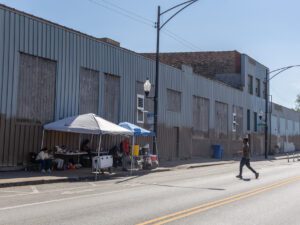 Mauricio Peña/Borderless Magazine
Mauricio Peña/Borderless MagazineCity and state officials rolled out recommendations for the ‘One System Initiative,’ which would include an intake zone accessible every day of the year for anyone experiencing homelessness.
The City of Chicago recently unveiled a report that offers guidance on how it could combine its homeless and migrant shelter systems.
Entitled “One System Initiative Recommendations,” the report outlined a set of suggestions for the city and state to consider as they move forward with the planning process for a combined migrant and homeless shelter system. Among the recommendations, the city could create an intake zone available for those in need at all hours.
The report, which is the first phase of the combined shelter systems, was prepared by consulting agencies with input from dozens of community organizations and government agencies.
News that puts power under the spotlight and communities at the center.
Sign up for our free newsletter and get updates twice a week.
“The City and State recognize that people with lived expertise and community organizations working in or otherwise interacting with the legacy homeless service system and new arrivals system have invaluable insight and thus engaged them to provide recommendations to work toward for a unified system,” said Daisy Contreras, deputy director of communications for the Illinois Department of Human Services.
Borderless put together this explainer to help you understand the One System Initiative and what could come next in its implementation.
What is the One System Initiative?
The One System Initiative refers to the effort by the City of Chicago and the State of Illinois to combine Chicago’s migrant and homeless shelter systems.
In mid-September, the city released a 23-page report with recommendations for how the One System arrangement should look.
The report was developed with the input of working groups consisting of over 45 local immigration social service providers and community leaders serving people experiencing homelessness. Some of these include:
- Illinois Coalition for Immigrant and Refugee Rights
- Cornerstone Missionary Baptist Church
- Brighton Park Neighborhood Council
- Mujeres Latinas en Accion
- New Life
- Salvation Army
- United African Organization
What recommendations were proposed for the One System Initiative?
The report made more than a dozen recommendations, including having the city freeze the number of shelter beds available for new arrivals and people experiencing homelessness and creating an intake zone available 24 hours per day, 365 days a year for anyone who might need to access shelter.
Other recommendations include:
- Develop real-time data tracking of bed availability
- Establish an effective and timely virtual access point for all populations experiencing homelessness and housing instability
- Build a prioritization process for shelter beds
- Build a workforce development and economic security strategy that supports people experiencing housing instability and homelessness
- Establish a Landlord Incentives and Risk Mitigation Fund
Read the full report by clicking the file below:
Read More of Our Coverage
How could this change the existing migrant and homeless shelter systems?
The report recommends two main changes: making all city-funded shelter beds available to anyone experiencing homelessness and creating a physical location that would serve as an intake zone for people who need a shelter bed available 24 hours per day, 365 days a year.
Under the current systems, migrants can stay in the city’s homeless shelters, but people experiencing homelessness cannot stay at a migrant shelter, according to the report.
As of late June, there were about 3,000 shelter beds in the homeless shelter system and 11,000 shelter beds for new arrivals. The report proposes maintaining the total number of beds at 14,000 until more evaluations are conducted to determine the number of beds necessary to meet the needs of Chicago’s unhoused community.
The report noted that because of the “limited number of shelter beds” currently available in Chicago’s homeless response system, almost two out of three people who request a homeless shelter bed in Chicago are not able to access one through the city.
Historically, those experiencing homelessness have to call 311 or go to the Garfield Community Service Center to request a shelter bed. That process posed barriers for people experiencing homelessness, as people cited “difficulty getting connected to a shelter and inconsistent processes told to them depending on where they initially attempt to access services,” the report notes.

A similar system has existed for migrant shelter intake, in which new arrivals go to the city’s Landing Zone or Intake Center in order to be placed at one of the city’s migrant shelters.
The report recommends marrying these two intake systems and creating at least “one low-barrier access point that is available 24/7 and 365 days a year, where residents can get their basic needs met, be assessed for diversion and shelter placement, and seek shelter when bed(s) are available.”
Who is responsible for the One System Initiative?
The One System Initiative is a collaboration between the City of Chicago and the State of Illinois. The city and state departments involved with the effort include the:
- Illinois Department of Human Services (IDHS)
- Office of the Governor of Illinois
- Office of the Mayor of Chicago
- Chicago Department of Family and Support Services (DFSS)
- Illinois Office to Prevent and End Homelessness (IOPEH)
Some of the funding for the initiative comes from the Illinois Office to Prevent and End Homelessness.
When will I start seeing changes to the city’s migrant and homeless shelter systems?
The multi-phase process is still in its early stages. The next step is for the city and state to take those recommendations and formulate an official action plan for the unified shelter systems.
A timeline, funding plan, and budget approval have not yet been established, Contreras said.
“We want to note that the State and City each operate on a fiscal year basis, with annual budgets passed and covering each fiscal year,” Contreras said.
Katrina Pham is Borderless Magazine’s audience engagement reporter. Email Katrina at [email protected].



